- Home
- About
- Map
- Trips
- Bringing Boat West
- Migration West
- Solo Motorcycle Ride
- Final Family XC Trip
- Colorado Rockies
- Graduates' XC Trip
- Yosemite & Nevada
- Colorado & Utah
- Best of Utah
- Southern Loop
- Pacific Northwest
- Northern Loop
- Los Angeles to NYC
- East Coast Trips
- Martha's Vineyard
- 1 Week in Quebec
- Southeast Coast
- NH Backpacking
- Martha's Vineyard
- Canadian Maritimes
- Ocracoke Island
- Edisto Island
- First Landing '02
- Hunting Island '02
- Stowe in Winter
- Hunting Island '01
- Lake Placid
- Chesapeake
- Provincetown
- Hunting Island '00
- Acadia in Winter
- Boston Suburbs
- Niagara Falls
- First Landing '99
- Cape Hatteras
- West Coast Trips
- Burning Man
- Utah Off-Roading
- Maui
- Mojave 4WD Course
- Colorado River Rafting
- Bishop & Death Valley
- Kauai
- Yosemite Fall
- Utah Off-Road
- Lost Coast
- Yosemite Valley
- Arizona and New Mexico
- Pescadero & Capitola
- Bishop & Death Valley
- San Diego, Anza Borrego, Joshua Tree
- Carmel
- Death Valley in Fall
- Yosemite in the Fall
- Pacific Northwest
- Utah Off-Roading
- Southern CA Deserts
- Yosemite & Covid
- Lake Powell Covid
- Eastern Sierra & Covid
- Bishop & Death Valley
- Central & SE Oregon
- Mojave Road
- Eastern Sierra
- Trinity Alps
- Tuolumne Meadows
- Lake Powell Boating
- Eastern Sierra
- Yosemite Winter
- Hawaii
- 4WD Eastern Sierra
- 4WD Death Valley +
- Southern CA Deserts
- Christmas in Tahoe
- Yosemite & Pinnacles
- Totality
- Yosemite & Sierra
- Yosemite Christmas
- Yosemite, San Diego
- Yosemite & North CA
- Seattle to Sierra
- Southwest Deserts
- Yosemite & Sierra
- Pacific Northwest
- Yosemite & South CA
- Pacific Northwest
- Northern California
- Southern Alaska
- Vancouver Island
- International Trips
- Index
- Tips
- Books
- Photos/Videos
- Search
- Contact
White Sands National Monument, NM
Thursday, August 1, 2002 - 12:00pm by Lolo
235 miles and 5 hours from our last stop - 1 night stay
Travelogue
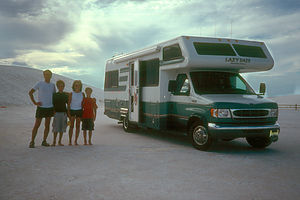 Family & Lazy DazeAfter prematurely aborting our hike in Guadalupe Mountains National Park because of the bugs and oppressive heat, we headed to our next destination, the fantastic white gypsum sand dunes of White Sands National Monument in Alamogordo, New Mexico. I must say that our drive there was fairly uninspiring—flat and dusty with oil derricks as far as the eye could see. This was definitely not one of the more scenic parts of the West.
Family & Lazy DazeAfter prematurely aborting our hike in Guadalupe Mountains National Park because of the bugs and oppressive heat, we headed to our next destination, the fantastic white gypsum sand dunes of White Sands National Monument in Alamogordo, New Mexico. I must say that our drive there was fairly uninspiring—flat and dusty with oil derricks as far as the eye could see. This was definitely not one of the more scenic parts of the West.
As we approached White Sands along Highway 70, we noticed the signs warning that the highway could be closed for up to 2 hours when the White Sands Missile Range was performing missile testing. This was the site of the famous “Manhattan Project,” where the first atomic bomb was tested back in 1945. The Missile Range, which completely surrounds the National Monument, is still an active testing site for space technology and experimental weaponry. Fortunately, no testing was being done today so we were able to drive right on through.
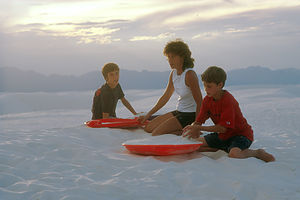 Lolo and boys on dunesSince the day was still oppressively hot and the sun was too high for good photography, we decided to drive right by the National Monument for now and come back later in the day when things had hopefully cooled down—as they usually do in the desert. About 20 miles north, in the town of Alamogordo, we found a great KOA campground where we took advantage of the pool for a good part of the afternoon. Feeling much refreshed, we were now ready to hit the dunes. After a brief stop at the campground store to rent some saucers (just like the kind you use in snow), we headed back down Highway 70 to the National Monument.
Lolo and boys on dunesSince the day was still oppressively hot and the sun was too high for good photography, we decided to drive right by the National Monument for now and come back later in the day when things had hopefully cooled down—as they usually do in the desert. About 20 miles north, in the town of Alamogordo, we found a great KOA campground where we took advantage of the pool for a good part of the afternoon. Feeling much refreshed, we were now ready to hit the dunes. After a brief stop at the campground store to rent some saucers (just like the kind you use in snow), we headed back down Highway 70 to the National Monument.
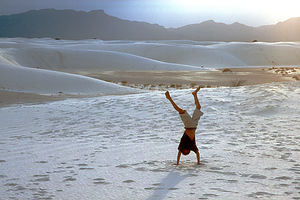 Andrew's dune handstandThe best way, and really the only way, to see the park is to drive the 8-mile scenic loop into the heart of the dunes. The road starts off paved, but soon turns to compacted white gypsum, yet still easy to drive on. We were definitely wise to wait for the low lighting. The landscape, or more correctly, moonscape, was eerie—miles and miles of brilliant white sand dunes surrounded in the distance by the peaks of the San Andreas Mountains. To make our experience seem even more otherworldly, there was not another soul in sight.
Andrew's dune handstandThe best way, and really the only way, to see the park is to drive the 8-mile scenic loop into the heart of the dunes. The road starts off paved, but soon turns to compacted white gypsum, yet still easy to drive on. We were definitely wise to wait for the low lighting. The landscape, or more correctly, moonscape, was eerie—miles and miles of brilliant white sand dunes surrounded in the distance by the peaks of the San Andreas Mountains. To make our experience seem even more otherworldly, there was not another soul in sight.
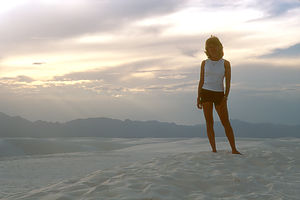 Lolo of the DuneAlthough I’m not usually a geology buff, I was curious as to how these gypsum dunes came to be. This is the condensed version of what I learned in the Visitor Center. The gypsum came from the rocks in the San Andreas Mountains which surround this basin. Rain and melting snow dissolved the gypsum in the rock and washed it down into Lake Lucero. When the water in the lake evaporated, the gypsum was left behind. Then the wind took over, blowing the crystallized gypsum over the desert covering everything in its path and creating the dunes. The wind is still doing its work, constantly changing the dunes and moving them up to 20 feet per year.
Lolo of the DuneAlthough I’m not usually a geology buff, I was curious as to how these gypsum dunes came to be. This is the condensed version of what I learned in the Visitor Center. The gypsum came from the rocks in the San Andreas Mountains which surround this basin. Rain and melting snow dissolved the gypsum in the rock and washed it down into Lake Lucero. When the water in the lake evaporated, the gypsum was left behind. Then the wind took over, blowing the crystallized gypsum over the desert covering everything in its path and creating the dunes. The wind is still doing its work, constantly changing the dunes and moving them up to 20 feet per year.
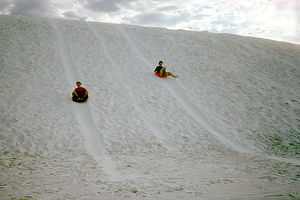 Boy's on saucers, zooming towards a Wal-MartNow that I understood the dunes better, it was time to experience them first hand. There were numerous places along the scenic loop to pull over and park. After spending far too much time in search of the perfect dune, we finally made our selection. The kids and I grabbed our saucers, and climbed to the top of a beautiful, brilliant white dune that must have been more than 50 feet high. Herb stayed at the base of the dune to set up his camcorder on a tripod, always ready to capture our family’s “Kodak” moments.
Boy's on saucers, zooming towards a Wal-MartNow that I understood the dunes better, it was time to experience them first hand. There were numerous places along the scenic loop to pull over and park. After spending far too much time in search of the perfect dune, we finally made our selection. The kids and I grabbed our saucers, and climbed to the top of a beautiful, brilliant white dune that must have been more than 50 feet high. Herb stayed at the base of the dune to set up his camcorder on a tripod, always ready to capture our family’s “Kodak” moments.
Once Herb signaled us for family fun to begin, we jumped on our saucers expecting to soar down the hill. However, to our dismay our saucers barely made it to the bottom. Undaunted, we tried again. We found that if we followed our tracks from the previous run, our speed gradually increased. Still not satisfied with our speed, we did something I’m embarrassed to admit. We sprayed Pam on the bottom of our saucers hoping to have the same effect that Clark Griswold had in Christmas Vacation when he almost flew through a Wal-Mart on his sled. Herb told me I was probably disrupting the delicate balance of the desert ecology by introducing vegetable oil to the environment. He made me feel quite guilty until I realized he was kidding. The spray definitely did help. We now were having some pretty good runs.
As the sun got lower, Herb and I sat on top of the dune with a glass of wine and watched an incredible sunset. Then, after much desanding—and believe me, it was everywhere—we drove out along the gypsum road in the twilight. What a truly spectacular place—unlike any other we’ve ever been to.
Description
White Sands National Monument, just west of Alamogordo in southern New Mexico, contains one of the most unique wonders of the Southwest—275 acres of glistening white gypsum sand dunes, the largest white gypsum dune field in the world.
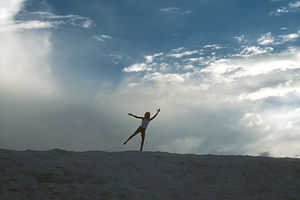 Lolo frolicking on dunesThese brilliant white dunes were formed over millions of years as melting snow and rain dissolved the gypsum in the rocks of the San Andres Mountains and carried it down into Lake Lucero. When the water in the lake evaporated, the gypsum was left behind. Gradually the strong southwesterly winds in the area blew the crystallized gypsum over the desert covering everything in its path and creating the dunes. These dunes are still constantly changing and advancing up to 20 feet per year.
Lolo frolicking on dunesThese brilliant white dunes were formed over millions of years as melting snow and rain dissolved the gypsum in the rocks of the San Andres Mountains and carried it down into Lake Lucero. When the water in the lake evaporated, the gypsum was left behind. Gradually the strong southwesterly winds in the area blew the crystallized gypsum over the desert covering everything in its path and creating the dunes. These dunes are still constantly changing and advancing up to 20 feet per year.
The best way to see the dunes is to drive the 8-mile scenic Dune Drive into the heart of the dunes. The road is paved at first but then becomes compacted gypsum. Blowing sand usually covers the surface. There are numerous pullouts along the way to park your car and get out and climb the dunes.
The White Sands Missile Range, which completely surrounds the park, was the site of the "Manhattan Project" where the first atomic bomb was tested in 1945. It is still an important testing site for space technology and experimental weaponry. The National Monument and U.S. 70 are sometimes closed for up to 2 hours when testing is being done on the Missile Range.
Videos
-
White Sands National Monument Dune Sliding on Saucers
- ‹ previous
- 9 of 36
- next ›
White Sands National Monument location map in "high definition"
Javascript is required to view this map.

Hi Lolo!
Looks like it's been awhile since you went on this trip out to White Sands, but I really enjoyed your blog and pictures.
My husband & I are taking his kids (Natalie 14 & Nick 12) out there the 1st week of August, and I think they would love to do the saucer sliding that you and your kids were doing.
Your site is fun! Thanks,
Mindy
White Sands National Monument is best visited in the Summer evenings when there is a full moon and the skies are clear. You can enter the park no later than 9:00 pm and have to leave by 10:00, so go at sunset and stay until 10:00. They are incredible to see at night during a full moon.
Thank you Pat. That sounds like great advice - The dunes were awesome at sunset and I wish we could have stayed a bit longer. We'll have to go back when the moon is full to see if I can get a dune photo by moonlight!